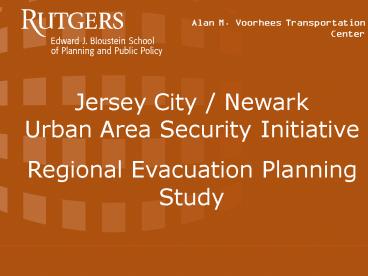Jersey City Newark - PowerPoint PPT Presentation
1 / 16
Title:
Jersey City Newark
Description:
Richard Kelly (Original author of the Trans-Hudson Emergency transportation plan) ... Prepared by: Jill Grodkiewicz and Jon Carnegie. Alan M. Voorhees ... – PowerPoint PPT presentation
Number of Views:97
Avg rating:3.0/5.0
Title: Jersey City Newark
1
Jersey City / Newark Urban Area Security
Initiative Regional Evacuation Planning Study
2
Purpose of Study
- Develop a collaborative, cross-jurisdictional and
multi-agency, all-hazards regional evacuation
plan for the northern New Jersey UASI region.
3
Research Team
- Voorhees Transportation Center
- Transportation planning and policy
- Outreach and public involvement
- GIS and travel demand modeling
- National Transit Institute
- Emergency management and transportation security
- Bloustein Center for Survey Research
- Department of Civil and Environmental Engineering
- Travel demand and evacuation modeling
- Subject matter experts
- Mariana Leckner (Emergency Management consultant)
- Richard Kelly (Original author of the
Trans-Hudson Emergency transportation plan) - Marketing (TBD)
- Traffic operations (TBD)
4
Goal and Objectives
- Goal Enhance the regions evacuation planning
capabilities - No silver bullet or absolute answers
- Objectives
- Inventory assets and resources
- Develop foundational understanding of how the
regions transportation network may function
under different scenarios and assumptions - Identify critical vulnerabilities and impediments
to successful evacuation, shelter-in-place and
reentry/recovery efforts - Explore opportunities for coordination and
collaboration - Identify needs related to collaborative
arrangements/mutual aid - Identify training and education needs
- Strengthen existing framework for on-going
regional cooperation and collaboration
5
Planning process will address
- Command, control and management issues
- Evacuation routing and clearance time estimates
- Evacuation of special needs populations
- Coordination with mass care/sheltering and animal
evacuation/sheltering plans - Cooperative and mutual-aid arrangements
- Ingress/re-entry plans for the safe return of
displaced populations
6
Scope of Work
- Conduct literature review
- Review modeling state-of-the-practice
- Identify planning scenarios assumptions (up to
10 scenarios) - Review county and local plans and annexes
- Inventory evacuation-related assets and resources
- Develop regional evacuation planning
transportation model
7
Scope of Work (p.2)
- Design and implement agency coordination and
public participation plan - Interviews and listening sessions
- UASI evacuation steering committee
- Agency/stakeholder working group
- Topical committees/working groups (as needed)
- Region-wide resident survey
- Disaster preparedness
- Evacuation behavior
- Information dissemination strategy
- Public information/education plan conduct
public forums
8
Scope of Work (p.3)
- Prepare plan and functional annexes
- Command, control and management
- Public notification and communication
- Evacuation routing plans and corridor/mode-specifi
c sub-plans - Plans/protocols for evacuating transportation-disa
dvantaged and special needs populations - Trans-Hudson evacuation
- Cooperative arrangements and mutual aid
agreements - Coordination with other target capability
planning initiatives - Recovery/re-entry plans and protocols
- Training and exercise plan
- Procedures for updating the plan and model
9
Schedule
10
Challenges
- Scale and scope of the region
- Adapting traditional planning methods to a
disaster planning process - Worst-case planning unfamiliar
- Many hypothetical assumptions and unknowns
- Emergency managers not accustomed to open,
transparent planning process - Modeling the behavior of a population not
accustomed to evacuation - Using conventional transportation planning tools
to address an unconventional problem - Bridging the gap between cooperation and
coordination - Cooperation is informal and built on personal
relationships - Coordination is more formalized and built on
institutional arrangements
11
Scale and scope of the region
12
Adapting traditional planning methods to
disaster planning context
- Worst-case is planning unfamiliar to most
- Involves many hypothetical assumptions and
unknowns - Emergency managers not accustomed to open,
transparent planning process
Source www.foxnews.com/.../083105_Katrina2.jpg
13
Modeling evacuation behavior is complex
Prepared by Jill Grodkiewicz and Jon Carnegie
14
Using conventional transportation planning tools
to address an unconventional problem
- Regional model provides snapshot of how regional
transportation systems may work - Macro-scale
- Course grained network
- Static OD
- Micro-scale simulation models provide greater
local definition and dynamic travel assignments - No-notice events are a particular challenge
- Shadow evacuation is also challenging to model
North Jersey Regional Transportation Model
(NJRTM)
15
Bridging the gap b/w cooperation and coordination
Cooperation
Coordination
Informal and built on personal relationships
Formalized and built on institutional
arrangements
16
Discussion
- Thank you!
- Contact information
- Jon A. Carnegie, AICP/PP, Executive Director
- Alan M. Voorhees Transportation Center
- Rutgers, The State University of New Jersey
- Tel 2-6812 ext. 606
- Email carnegie_at_rci.rutgers.edu































